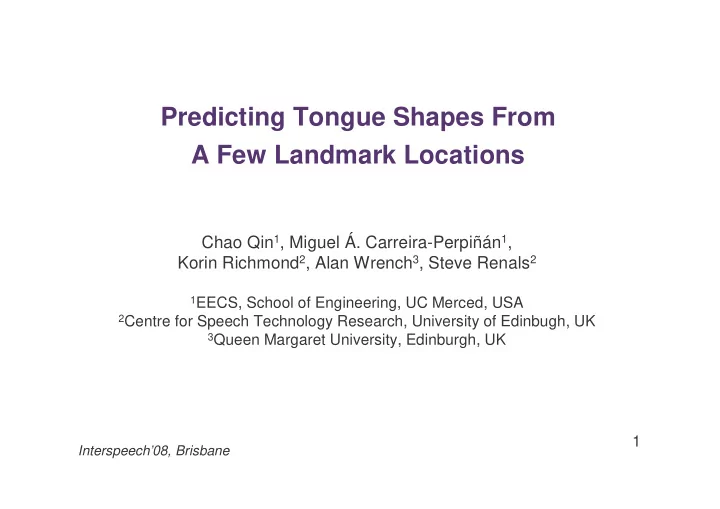

Predicting Tongue Shapes From A Few Landmark Locations Chao Qin 1 , Miguel Á. Carreira-Perpiñán 1 , Korin Richmond 2 , Alan Wrench 3 , Steve Renals 2 1 EECS, School of Engineering, UC Merced, USA 2 Centre for Speech Technology Research, University of Edinbugh, UK 3 Queen Margaret University, Edinburgh, UK 1 Interspeech’08, Brisbane
Introduction • Tongue is the most important speech production articulator • Articulatory datasets only provide sparse representation of tongue. Wisconsin X-ray microbeam MOCHA • Questions 1. Are these 3 or 4 pellets sufficient to reconstruct the tongue shape? 2. How many are necessary for an accurate reconstruction? 2 3. Where to place them optimally?
Machine learning approach • Assume midsaggital contours • Collect a training set of tongue contours (ground truth) � � , . . . , � � ∈ � � • Predict a test contour from the location of pellets using a � � K nonlinear regression: � � � � � � • Estimate the mapping from the training set (least-square) � � � � � � � K �� 3
Data collection • Ultrasound data of tongue movement Midsagittal tongue contour Teeth shadow Hyoid bone shadow (front) (back) 4
Data collection • Ultrasound machine and head stabilization device (QMU) 5
Data collection • Tongue contour tracking – A difficult task due to noisy ultrasound images – Tongue parts are invisible from time to time – Our solution: automatic + manual correction • Automatic tracking by EdgeTrak ( Li et al’ 05 ), based on snake segmentation • Tongue contour dataset – One native English speaker with Scottish accent – 20 read TIMIT sentences – tongue contours and audio N � ����� • Each contour = 2D position of 24 points � ∈ � � � �� 6
Reconstructing tongue shape from a few landmarks � ∈ � � � �� � ∈ � � � � ��� K � � • Unsupervised spline interpolation – Uses only information in the landmarks K – Smooth but easy to penetrate the palate or teeth, poor extrapolation • Supervised prediction: learn mapping using a training set � � � � � � – Linear prediction – Nonlinear prediction � � � � � � � � φ � � � � , φ � � � � � ��� � − � � � � � − � � � /σ � � � • We use Gaussian Radial Basis Function networks (RBF) – Universal mapping approximator – Simple and fast training 7
Experimental results F3 F97 F205 F428 F553 F711 F663 Frame 754 N−point contour Cubic B−spline RBFs K=3 landmarks 10 mm 10 mm 8
Experimental results by RBF prediction � � � • Landmarks : test each of the combinations, � P � �� , K � � , � , � , � � • Ignore unreasonable arrangements of landmarks – Divide the contour into consecutive segments K – Constrain each landmark to select points from one segment RMSE (mm) RMSE (mm) K Tongue position 9
Experimental results by spline interpolation • Run spline interpolation on the same landmarks’ locations as RBF • Worse than RBF prediction by an order of magnitude RMSE (mm) RMSE (mm) K Tongue position 10
Optimal locations of landmarks Practical rule: quasi-equidistant placement, more landmarks on the tongue tip 11
Conclusions • Using 3 or 4 landmarks is sufficient to predict the tongue shape by a nonlinear mapping with RMS error below 0.4mm • Nonlinear prediction can predict very realistic tongue shapes and is much more reliable than spline interpolation • Useful for determining optimal number and locations of landmarks for EMA and X-ray microbeam techniques • Small deviations from the optimal landmark locations increase the error only slightly • Approach applicable to reconstruct 3D tongue shapes if 3D data available • Future work – Speaker adaptation – Tongue contour animation for vocal tract visualization – Augment tongue pellets in MOCHA and X-ray datasets, eg. for articulatory inversion • Supported by NSF CAREER award IIS-0754089 and Marie Curie Early Stage Training Site EdSST (MESTCT-2005=020568) 12
Acknowledgement • Thanks D. Massaro and M. Cohen (UC Santa Cruz) for useful discussions 13
Recommend
More recommend